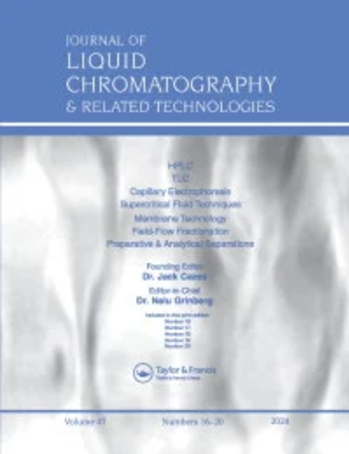使用成像毛细管等电聚焦对贝伐单抗生物类似物制剂电荷变体的相似性评估
IF 1
4区 化学
Q4 BIOCHEMICAL RESEARCH METHODS
Journal of Liquid Chromatography & Related Technologies
Pub Date : 2021-10-02
DOI:10.1080/10826076.2022.2072329
引用次数: 2
摘要
摘要开发并验证了成像毛细管等电聚焦方法,用于贝伐单抗创新产品及其生物仿制药制剂的电荷变化分析(N = 2) 。优化的方法包括:;4. M尿素,2.0 mM亚氨基二乙酸,0.35%m/v甲基纤维素,5.0 mM L-精氨酸,4.0%v/v载体两性细胞(比例为1:3的窄范围等电点5–8和8–10.5),60 mM氢氧化钠和30 mM磷酸作为阴极电解液和阳极电解液溶液。贝伐单抗创新者和生物仿制药制剂观察到有两个酸性峰,然后是主峰和两个碱性峰。所开发方法的验证是通过执行日内(n = 6) 和interday(n = 9) 精密度研究,观察到的RSD<2.0%。所开发的方法的检测极限和定量极限分别为0.016和0.048 mg mL−1。创新者和生物仿制药配方的电荷变化曲线(N = 2) 然后使用单因素方差分析、Dunnett检验进行统计比较。这项研究可以为生物仿制药制造商和初创公司在生产过程中如何评估贝伐单抗的电荷变化情况提供参考。图形摘要本文章由计算机程序翻译,如有差异,请以英文原文为准。
Similarity assessment of charge variants for bevacizumab biosimilar formulations using imaged capillary isoelectric focusing
Abstract The imaged capillary isoelectric focusing method was developed and validated for charge variant analysis of the bevacizumab innovator product and its biosimilar formulations (N = 2). The optimized method consists of; 4 M urea, 2.0 mM iminodiacetic acid, 0.35% m/v methylcellulose, 5.0 mM L-arginine, 4.0% v/v carrier ampholytes (narrow-range isoelectric point 5–8 and 8–10.5 with ratio of 1:3), 60 mM sodium hydroxide and 30 mM phosphoric acid as catholyte and anolyte solutions. The bevacizumab innovator and biosimilars formulations were observed with two acidic peaks followed by the main peak and two basic peaks. The validation of the developed method was done by performing intraday (n = 6) and interday (n = 9) precision studies with observed RSD < 2.0%. The limit of detection and limit of quantification of the developed method was found to be 0.016 and 0.048 mg mL−1. The charge variant profiles observed for innovator and biosimilar formulations (N = 2) were then applied for statistical comparison using one-way ANOVA, Dunnett’s test. This study can serve as a reference to biosimilar manufacturers and startups on how to assess the charge variant profiles of bevacizumab during the manufacturing process. Graphical Abstract
求助全文
通过发布文献求助,成功后即可免费获取论文全文。
去求助
来源期刊
CiteScore
2.80
自引率
0.00%
发文量
29
审稿时长
4.9 months
期刊介绍:
The Journal of Liquid Chromatography & Related Technologies is an internationally acclaimed forum for fast publication of critical, peer reviewed manuscripts dealing with analytical, preparative and process scale liquid chromatography and all of its related technologies, including TLC, capillary electrophoresis, capillary electrochromatography, supercritical fluid chromatography and extraction, field-flow technologies, affinity, and much more. New separation methodologies are added when they are developed. Papers dealing with research and development results, as well as critical reviews of important technologies, are published in the Journal.

 求助内容:
求助内容: 应助结果提醒方式:
应助结果提醒方式:


